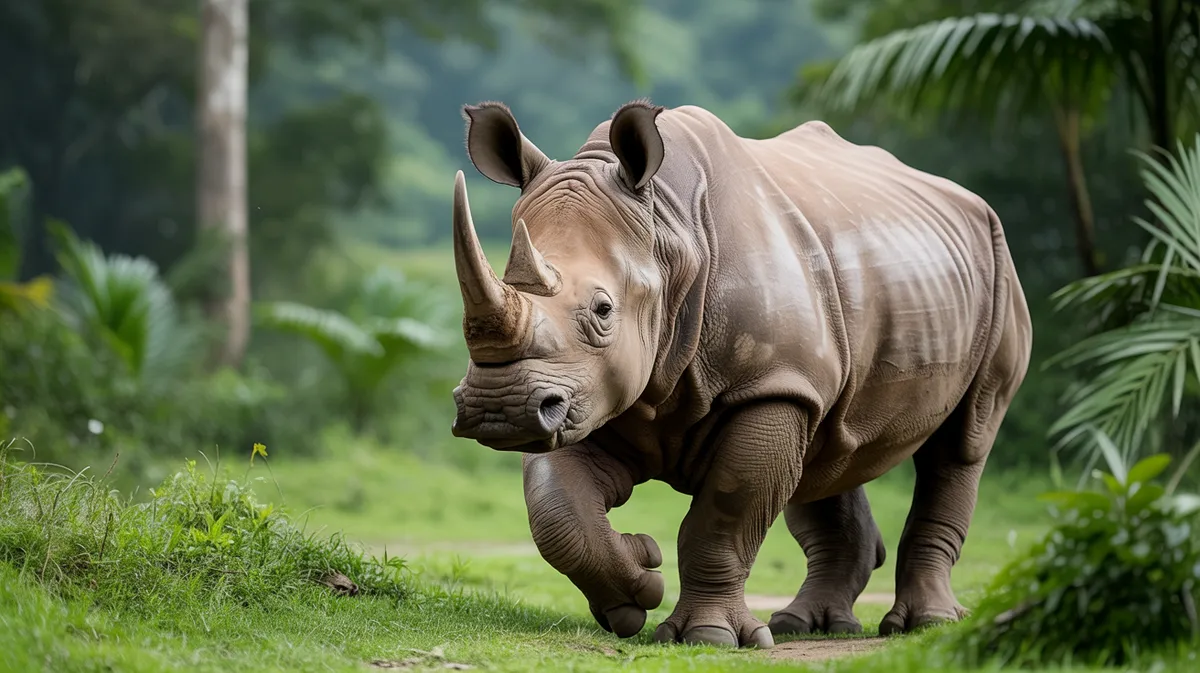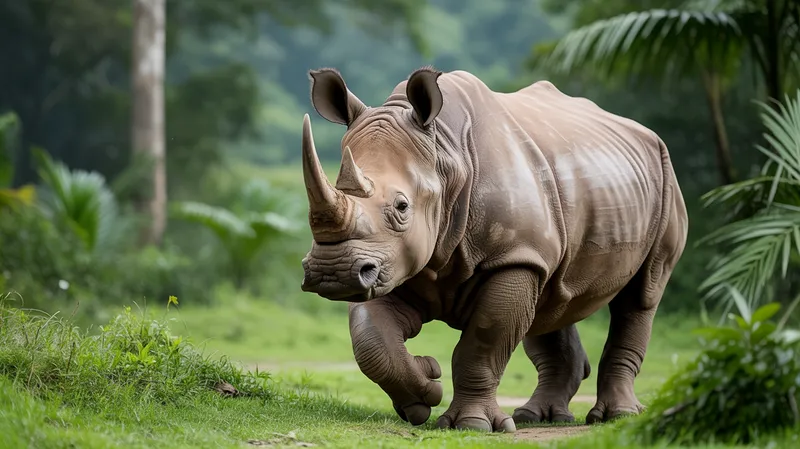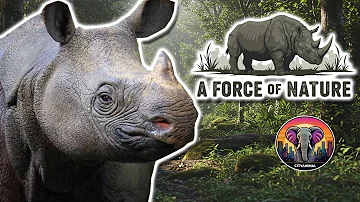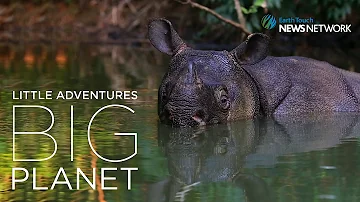
Javan Rhinoceros
Rhinoceros sondaicus

Meet the Javan Rhinoceros
The Javan Rhinoceros is one of the world’s rarest large mammals, native to the dense tropical forests of Southeast Asia. It is characterized by its single horn, greyish skin that forms loose folds, and relatively small size compared to other rhino species. Once widespread across much of Southeast Asia, today the Javan Rhinoceros survives in only one known population in Ujung Kulon National Park, Indonesia. Extremely shy and solitary, these rhinos are elusive and rarely seen, making them challenging to study and protect. Poaching and habitat loss have pushed the species to the brink of extinction.
Classification
Mammal
Habitat
Tropical lowland rainforest
Diet
Herbivore
Lifespan
30-45 years
Conservation
Critically Endangered
Weight
900-2,300 kg
📖Fascinating Facts
Single Horn
Unlike other Asian rhinos, the Javan rhinoceros has only a single horn, which is usually less than 25 cm long.
Forest Dweller
Javan rhinos prefer dense, lowland rainforests near water sources, making them hard to spot in the wild.
Extremely Endangered
With fewer than 80 individuals remaining, the Javan rhinoceros is considered one of the most endangered large mammals on Earth.
📋Detailed Description
The Javan rhinoceros (Rhinoceros sondaicus) is a medium-sized rhinoceros distinguished by its single, relatively small horn—typically less than 25 cm in length—present only in males. Adults measure 3.1–3.2 meters in body length, stand 1.4–1.7 meters at the shoulder, and can weigh up to 2,300 kg, making them one of the smallest living rhino species. Their skin is grayish-brown and forms characteristic loose folds, giving a plated appearance that provides some protection against predators and dense vegetation. Javan rhinos have a prehensile upper lip adapted for grasping leaves and twigs, and their incisor teeth are well-developed for browsing. They are primarily solitary and highly secretive, with individuals maintaining large, overlapping home ranges within dense lowland rainforest and swampy habitats. Their sense of smell and hearing are acute, compensating for relatively poor eyesight. Javan rhinos are crepuscular, being most active during dawn and dusk, and spend much of their time wallowing in mud to regulate body temperature and deter parasites. The species is currently restricted to a single wild population in Ujung Kulon National Park, Java, Indonesia, where fewer than 80 individuals survive. This isolation, combined with their elusive nature, makes direct observation and study challenging, and much of their ecology is inferred from indirect evidence such as footprints, dung, and camera trap images.
💡 Did you know?
There are fewer than 80 Javan Rhinoceroses left in the world, all living in a single forest in Indonesia.
🔬Research & Sources
Wikipedia Summary
The Javan rhinoceros, Javan rhino, Sunda rhinoceros or lesser one-horned rhinoceros is a critically endangered member of the genus Rhinoceros, of the rhinoceros family Rhinocerotidae, and one of the five remaining extant rhinoceros species in South Asia and Africa. It has a plate-like skin with protective folds and is one of the smallest rhinoceros species with a body length of 3.1–3.2 m (10–10 ft) and a 1.4–1.7 m long tail. The heaviest specimens weigh around 2,300 kg (5,100 lb). Its horn is usually shorter than 25 cm (9.8 in).
Last Modified: 5/17/2025
🎭Behavior & Social Structure
Javan rhinos are predominantly solitary, with adults only coming together for mating or, in the case of females, when accompanied by their calves. They are territorial but show tolerance for overlapping ranges, likely due to the low population density. Communication is primarily olfactory, using dung piles and urine spraying to mark territory and convey reproductive status. Vocalizations are rare but include snorts, grunts, and whistles, mainly during courtship or distress. Their diet consists mainly of shoots, twigs, young leaves, and fallen fruit from over 50 plant species, and they are selective browsers, often feeding along forest edges and clearings. Javan rhinos are known to wallow daily in mud pools, which helps in thermoregulation and parasite control. They are most active during early morning and late afternoon, resting in dense cover during the heat of the day. Despite their size, they are agile in dense undergrowth and are excellent swimmers, often crossing rivers and flooded areas within their habitat.
👶Reproduction & Life Cycle
Javan rhinos have a low reproductive rate, with females reaching sexual maturity at around 5–7 years and males at 10 years. Breeding can occur year-round, but births are most commonly recorded at the onset of the rainy season, possibly linked to food abundance. Courtship is brief and can be aggressive, with males sometimes inflicting wounds on females. After mating, the gestation period lasts approximately 15–16 months, resulting in the birth of a single calf weighing about 40–60 kg. Calves remain with their mothers for up to two years, during which time the mother is highly protective and does not breed again. There is little paternal involvement. The long inter-birth interval, typically 4–5 years, further limits population growth. Calves are weaned at about one year but continue to accompany the mother until the next offspring is born.
🛡️Adaptations & Survival
The Javan rhino exhibits several adaptations for survival in dense, humid forests. Its prehensile upper lip enables efficient browsing on a wide variety of vegetation, while its tough, folded skin provides protection against thorns, insect bites, and minor injuries. The species’ acute sense of smell and hearing compensate for poor eyesight, aiding in predator detection and navigation through thick undergrowth. Regular wallowing in mud serves both as a cooling mechanism and a barrier against ectoparasites. Their solitary and elusive behavior reduces the likelihood of detection by humans and natural predators. The small horn, present only in males, is used primarily for social dominance and defense rather than foraging. Their ability to swim and cross water bodies allows them to exploit a mosaic of habitats within their range.
🎨Cultural Significance
The Javan rhinoceros holds symbolic significance in Indonesian culture, representing the unique biodiversity of Java and the urgent need for conservation. Historically, its horn was valued in traditional medicine and as a status symbol, contributing to its decline. Today, the species is a flagship for conservation efforts in Indonesia, featured in local folklore and national campaigns. Its presence in Ujung Kulon National Park is a source of pride and a focal point for ecotourism, though direct sightings are rare. The rhino is also depicted in local art and literature as a symbol of strength and resilience.
🔬Recent Research & Discoveries
Recent research has focused on non-invasive monitoring techniques, such as camera traps, environmental DNA (eDNA) analysis, and dung surveys, to estimate population size and assess genetic diversity. Studies have revealed alarmingly low genetic variability, underscoring the need for careful management to avoid inbreeding depression. Habitat use and dietary preferences have been elucidated through GPS tracking and microhistological analysis of dung, informing habitat restoration efforts. Ongoing research includes the assessment of disease risks from livestock encroachment and the impact of invasive plant species on food availability. Conservationists are exploring the feasibility of establishing a second population in a secure location to reduce extinction risk. International collaborations are underway to share expertise and resources for the long-term survival of the species.
🎥Wildlife Videos

Javan Rhinoceros | animal documentary
Javan Rhinoceros | animal documentary The Javan Rhinoceros is one of the rarest and most threatened mammals on the planet.
Cityanimal EN

The Disappearing Act of the Javan Rhino
The Javan Rhino's mystery unfolds as conservationists race against time. #JavanRhino #Conservation #WildlifeProtection ...
Wild Wonders Unveiled

Javan Rhino’s Most Endangered Animals on Earth.
Javan Rhino Deep in the rainforests of Indonesia, one of the rarest animals on Earth fights for survival. The Javan rhino, once ...
A&K STORIES

A Rhino's Life: Survival in the Jaws of Danger | 4K UHD Documentary
"A Rhino's Life" offers an immersive look into the world of one of the planet's most iconic creatures. Captured in stunning 4K UHD, ...
space and science

Extraordinary journey to photograph the Javan Rhino
Wildlife photographer Stephen Belcher embarks on a precarious journey through the vast, almost impenetrable jungles of ...
Earth Touch

Javan Rhino • All You Need To Know About This Rhinoceros
What did you learn about the Javan Rhinoceros today? Let us know in the comments down below ▷ Animal Facts 101 brings ...
Animal Facts 101
🌍Habitat Information
The Javan Rhinoceros typically inhabits Tropical lowland rainforest environments. Javan Rhinoceross have adapted to their environments with specialized features and behaviors.
Primary Habitat:
Tropical lowland rainforest
More detailed habitat information will be available soon.
🛡️Conservation Status
The Javan Rhinoceros is currently classified as Critically Endangered. Conservation efforts are crucial for preserving this species for future generations.
Common Threats:
- 🏠Habitat loss and fragmentation
- 🌡️Climate change impacts
- 🎯Hunting and poaching
- 🏭Human-wildlife conflict
⚠️Threats & Conservation Challenges
The Javan rhinoceros faces severe threats, primarily from habitat loss, poaching, disease, and genetic bottleneck effects. Historically, the species ranged across Southeast Asia, but hunting for their horns and habitat conversion to agriculture have confined them to a single population in Ujung Kulon National Park. Although poaching has been largely curtailed in this protected area, the species remains highly vulnerable to stochastic events such as disease outbreaks (notably from livestock-borne pathogens), natural disasters (e.g., tsunamis, volcanic eruptions), and inbreeding depression due to extremely low genetic diversity. Invasive plant species, such as Arenga palm, are also degrading habitat quality by outcompeting native food plants. Conservation challenges include the difficulty of monitoring such a secretive animal, the need for habitat management, and the lack of suitable alternative sites for population expansion. Population estimates remain below 80 individuals, and the lack of subpopulations increases extinction risk.
🔬Scientific Classification
Scientific Name
Rhinoceros sondaicus
Classification Hierarchy
🔍 About Taxonomic Classification
Taxonomic classification is a hierarchical system used by scientists to classify and organize living organisms based on shared characteristics and evolutionary relationships.
The system moves from broad categories (Kingdom) to increasingly specific ones, with each animal's scientific name typically consisting of its Genus and species.
📝Community Notes
Share your observations and insights about the Javan Rhinoceros with our community of wildlife enthusiasts.
Join Our Community
Sign in to share your observations and connect with fellow wildlife enthusiasts.
Sign In to ContributeNo community notes yet
Be the first to share your observations about the Javan Rhinoceros!
Explore Javan Rhinoceros
Select a tab above to learn more about this amazing animal.
📸Photo Gallery
No photos available for this animal yet.
🌟Discover More Wildlife
Continue your journey of discovery with more fascinating animals from our database
